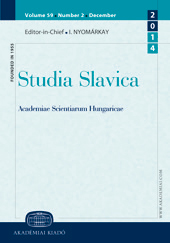Tendenzen und Richtungen in der ungarischen historischen Slavistik
Tendencies and directions in the Hungarian historical Slavistik
Author(s): Klára AgyagásiSubject(s): Theoretical Linguistics, Historical Linguistics, Comparative Linguistics, Finno-Ugrian studies, Philology
Published by: Akadémiai Kiadó
Keywords: Slavic loanwords; calques; Hungarian; the history of Slavic languages; inter- Slavic language contacts; areal linguistics;
Summary/Abstract: This paper aims at giving an overview of the main traditional tendencies and new trends in historical Slavic linguistics in Hungary. Traditionally, since the end of the 19th century, the main goal of investigations has been the interpretation of the Slavic linguistic and cultural influence on the Hungarian language and culture, having continuously been present in the Carpathian basin for more than a thousand year. The language contacts resulted in a vast number of lexical borrowings, calques, and toponyms of Slavic origin in Hungarian, and also in the appearance of Church Slavonic written sources of local redaction. The author describes the process of the methodological progress in the research of these areas and presents the most important results. Since the 1990’s, new trends have emerged in historical Slavic linguistics in Hungary that can be identified as the application of methods and frameworks of areal and theoretical (cognitive and generative) linguistics, which makes the renewal of this discipline possible.
Journal: Studia Slavica Academiae Scientiarum Hungaricae
- Issue Year: 58/2013
- Issue No: 1
- Page Range: 1-14
- Page Count: 14
- Language: German
- Content File-PDF

